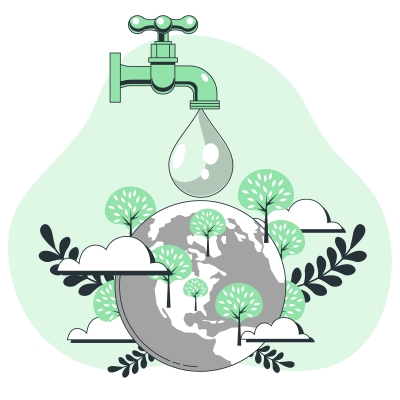Water Resources Class 10 Notes
Class 10
Welcome to the article on Water Resources Class 10 Notes. In this article, we will explore the crucial topic of water resources and the impact of their availability on the environment and human life. Water is a precious resource that is essential for all forms of life, and we will delve into the various aspects of water resources, including their distribution, usage, management, and conservation. With the global water crisis looming large, it is imperative to have a comprehensive understanding of this topic to address the challenges and sustainably manage our water resources. So, let's dive in and explore the world of water resources.
Water -Water Resources Class 10 Notes
-
Three-fourth of the earth’s surface is covered with water but only a small proportion of it accounts for freshwater, that can be put to use. Despite being a renewable resource, water scarcity is a growing concern in many parts of the world due to various reasons such as over-exploitation, excessive use, and unequal access to water among different social groups.
-
Over-exploitation of water resources is resulting in the expansion of irrigated areas for dry-season agriculture, which is leading to water scarcity in many areas. Additionally, the bad quality of water is also contributing to the water scarcity in some areas, even if sufficient water is available.
-
To address this issue, there is a pressing need to conserve and manage our water resources effectively. This will help in safeguarding ourselves from health hazards, ensuring food security, continuation of our livelihoods and productive activities, and preventing degradation of our natural ecosystems.
Multi-Purpose River Projects and Integrated Water Resources Management
In ancient times, people constructed sophisticated hydraulic structures like dams built of stone rubble, reservoirs or lakes, embankments, and canals for irrigation to conserve water. This tradition has been continued in modern India by building dams in most of our river basins.
Dams - Water Resources Class 10 Notes
The term "dam" refers to a barrier constructed across a flowing water body that obstructs, directs or retards the flow, often leading to the creation of a reservoir, lake or impoundment. The structure itself is not referred to as a "dam," rather the term applies to the resulting body of water.
Uses of Dam
- People build dams to impound rivers and rainwater, which can later be used to irrigate agricultural fields.
- Dams are also built for electricity generation purposes.
- Another reason for building dams is to provide water for domestic and industrial uses.
- Dams can also be constructed for flood control purposes.
- People may also build dams for recreation, inland navigation, and fish breeding purposes.
Side effects of Creating Dams - Water Resources Class 10 Notes
- The natural flow of rivers is affected by regulating and damming.
- Aquatic life in rivers is adversely impacted by this.
- Fragmentation of rivers due to dams makes it difficult for aquatic fauna to migrate.
- Construction of dams on floodplains leads to the submergence of existing vegetation and soil decomposition over time.
- The creation of large dams has led to environmental movements such as the ‘Narmada Bachao Andolan’ and the ‘Tehri Dam Andolan’ as local people have had to give up their land, livelihood and control over resources for the construction of the dam.
- Objections to the projects often arise due to their failure to achieve their intended purposes, such as controlling floods which are instead triggered by dams.
- Dams have also caused extensive soil erosion, earthquakes, water-borne diseases, pests, and pollution due to excessive use of water.
Have a look at the India Major Rivers and Dams in the map below:
Rain Water Harvesting
- Rainwater harvesting collects rainfall for future usage.
- People adopt different methods for rainwater harvesting in different areas.
- In hill and mountainous regions, diversion channels like 'guls' or 'kuls' are built for agriculture.
- 'Rooftop rainwater harvesting' is commonly practised in Rajasthan to store drinking water.
- In the flood plains of Bengal, inundation channels are developed to irrigate fields.
- In arid and semi-arid regions, agricultural fields are converted into rain-fed storage structures such as 'khadins' in Jaisalmer and 'Johads' in other parts of Rajasthan.
- Tankas are built inside the main house or courtyard for rainwater harvesting in Rajasthan, particularly in Bikaner, Phalodi and Barmer areas.
- Underground rooms are constructed adjoining the 'tanka' to beat the summer heat.
- Tamil Nadu has made rooftop rainwater harvesting structures compulsory for all houses across the state.
- Legal provisions exist to punish defaulters.
Conclusion
In conclusion, water resources play a critical role in our lives and the environment, and their management and conservation are essential to ensure a sustainable future. We have explored various aspects of water resources in this article, from their distribution and usage to their management and conservation. It is imperative that we take proactive steps to conserve and manage our water resources to address the challenges posed by the global water crisis. With the knowledge gained from this article, we hope that you are better equipped to understand the importance of water resources and contribute to their sustainable management. Let us all work together to protect this precious resource and ensure its availability for future generations.
Download the eSaral App for complete Class 10 Video lectures, Study material, revision and much more.
Water Resources Class 10 Notes
Also read,
Class 10 NCERT Science notes -All Chapters
Power Sharing Notes Class 10th
Democracy and Diversity Class 10 Notes
Popular Struggles and Movements Class 10 Notes
Challenges to Democracy Class 10 Notes
Sectors Of Indian Economy Class 10 Notes
Globalisation and the Indian Economy Class 10 Notes
